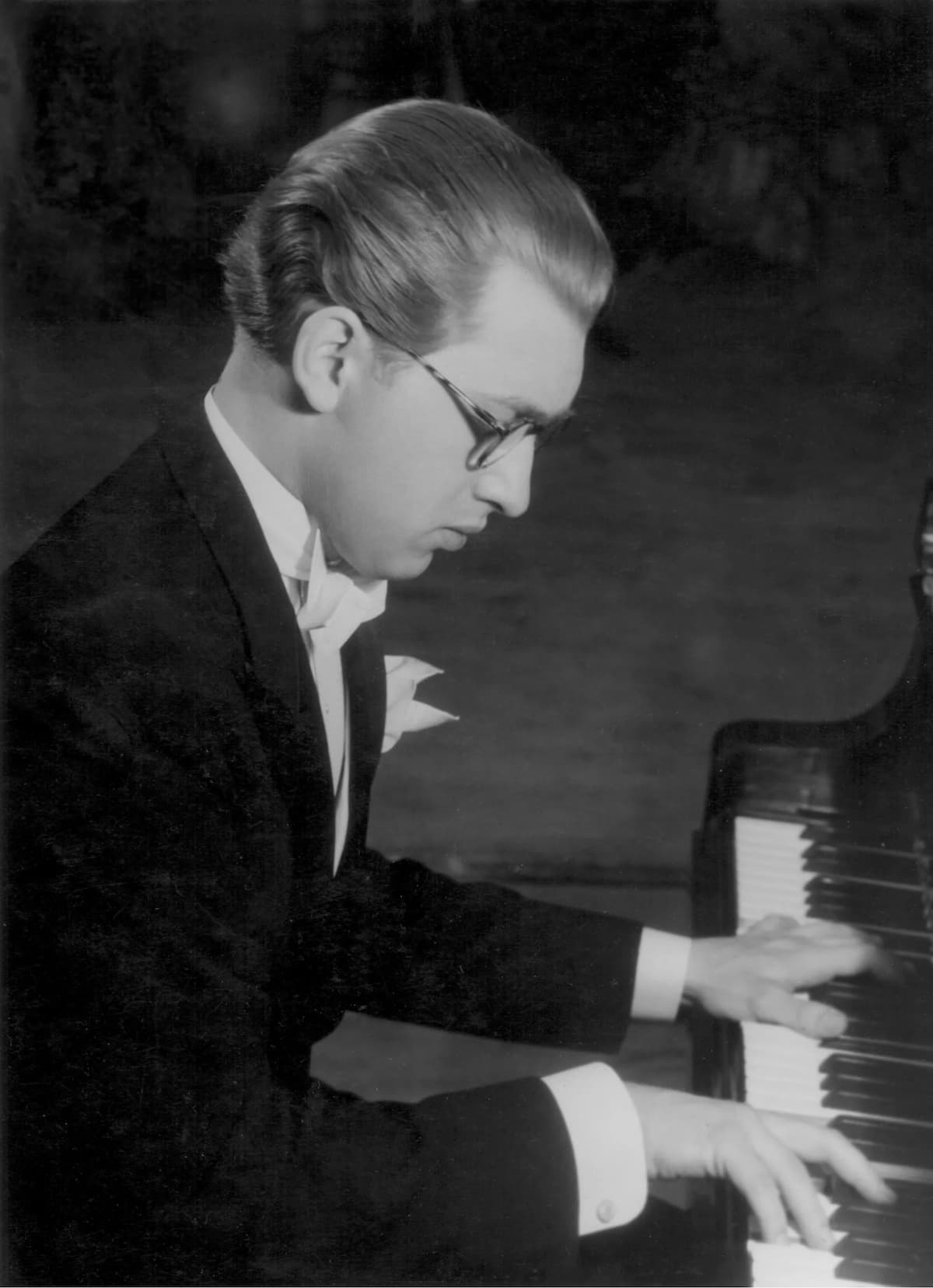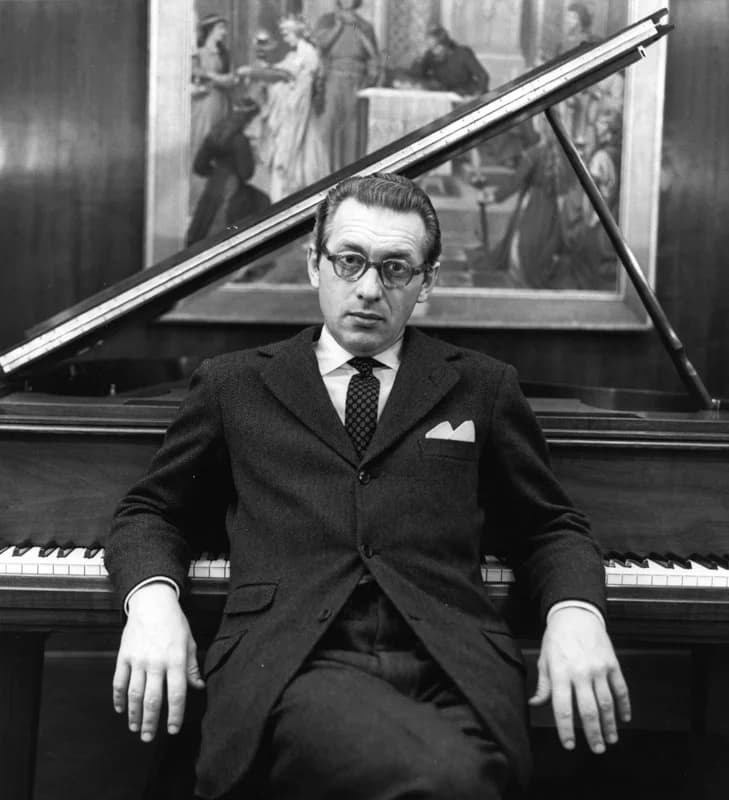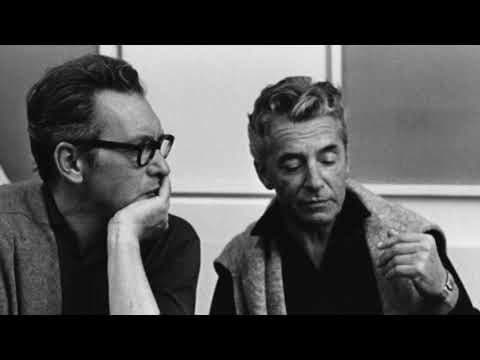The Swiss-Hungarian pianist Géza Anda was a celebrated interpreter of the classical and romantic repertoire. Capable of resolving the most strenuous difficulties into crystalline poetry and producing a unique tonal sheen and refined cantabile, Wilhelm Furtwängler famously called him “a troubadour of the keyboard.” Anda is noted for his performances and recordings of Mozart and his charismatic readings of Bartók, Schumann, and Liszt.
Géza Anda Perform Brahms’ Paganini Variations, Op. 35
Troubadour of the Keyboard

Géza Anda at the piano
Géza Anda was born in Budapest, Hungary, on 19 November 1921. The boy exhibited great musical talent at an early age and initially studied with Imre Stefaniai and Imre Keéri-Szántó. His father was determined that Géza should become an elementary school teacher, and to please his father, he did eventually pass his certification without distinction. However, it was clear early on that Anda would become a professional musician, entering the famed Liszt Academy at the age of 13.
At the Liszt Academy in Budapest, he studied composition with Zoltán Kodály and piano, on the recommendations of Wilhelm Backhaus, with Ernő von Dohnányi. As a biographer writes, “he quickly became known as a keyboard stud, a technically brilliant interpreter of Franck, Bartók and Liszt who could do on the instrument as he pleased with total ease.” By 1941 he had won two consecutive first prizes of the Budapest Franz Liszt Society, and given his recital debut with works by Bach–Busoni, Scarlatti, Schumann, Chopin, Debussy and Liszt. In the same year, Anda made his concerto debut under Willem Mengelberg in a performance of the Second Piano Concerto by Brahms.
César Franck: Symphonic Variations, M. 46 (Géza Anda, piano; Royal Concertgebouw Orchestra; Eduard van Beinum, cond.)
Approach to Music

Géza Anda
Anda’s approach to music was shaped at the Liszt Academy in Budapest, and is based on a rational, extremely detailed analysis of the musical text. With great concentration he closely examined the score before liberating himself completely in order to attain a highly individual, personal interpretation of the piece. As he once remarked, “If you want to interpret a work, you can’t learn it, you have to become completely at one with it.
Anda famously describe that process, “quite simply, you line up the notes one after the other with your fingers lying nicely. This is something achieved by the intellect, the nerve pathways and the auditory nerves. Listening to yourself properly is the key to ‘beautiful’ playing… While you’re playing, you have to gain a distance from yourself, or at least try to do so. I instruct myself to do what I will. It’s not a dogma. If it succeeds, then it’s good.”
Ludwig van Beethoven: Piano Sonata No. 28 in A Major, Op. 101 – II. Lebhaft. Marschmassig (Géza Anda, piano)
Approach to Interpretation

Géza Anda and Herbert von Karajan
Géza Anda was an outspoken participant in discussion on the aesthetics of music and interpretation. “Love, intuition and an analytical mind,” according to Anda, “allow us to unravel the musical score. Everything is contained within it. To seek the music behind the notes, as the platitude goes, is nonsense. The music is in the notes. When one note is joined by a second, then the music begins, and our work with it.”
As Anda explained, “musical problems are technical problems about conjuring up the musical structure and the inner content of a work at the piano, and technical problems are musical problems, because the only raison d’être of the instrument is to make music. If anyone here misses the concept of “feeling,” it is absent on purpose. The individual ego is of the greatest personal importance, but not in relation to the work to be interpreted. The work has laid down its own emotional and atmospheric content in the musical text, and it is our task to extract it, not to put our own stamp on it, depending on our own moods.”
Wolfgang Amadeus Mozart: Piano Concerto No. 21 in C Major, K. 467 (Géza Anda, piano/cond.; Camerata Salzburg)
Going Abroad

Anda grew up under the government of Miklós Horthy, a legislative body with clear pro-Fascist tendencies. Shortly before being drafted into the Hungarian army, he received a scholarship to study abroad. Anda had a choice between studying in Rome or Berlin, and he selected the latter. Anda experienced his first taste of fame playing under Furtwängler in 1942, and thanks to an attaché at the Swiss embassy, who bribed the Gestapo, he was granted a stay at a Swiss spa. Anda forgot to return to Germany and eventually settled in Zurich permanently.
Anda was an early star of the recording world and the first pianist to record all Mozart piano concertos, conducting them from the keyboard and featuring his own cadenzas. His discography includes 100 works on some 200 recordings, released on Columbia/EMI and Deutsche Gramophone. A critic writes, “Anda plays with an amazing array of tonal colours and dynamic shadings, remarkably refined use of pedalling, incredible timing (including a few tongue-in-cheek nuances), masterful nuancing, mindful articulation, and burnished phrasing … the list could go on and on. You’ve probably never heard anything like it! Magical pianism!
For more of the best in classical music, sign up for our E-Newsletter
